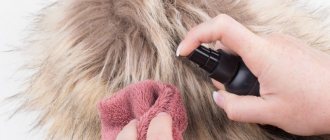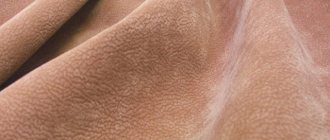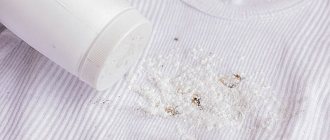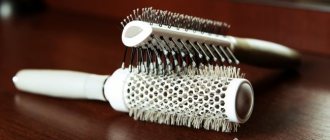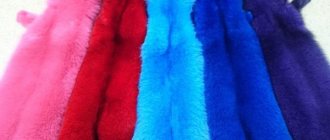A fur coat made from a white fox is easily soiled clothing, but the fur can be cleaned at home.
Unfortunately, natural fur changes the color and quality of the pile over time - this is inevitable. The aging process of a fur coat cannot be stopped, but with proper care it can be significantly slowed down. Is it possible to clean a coat with a fox collar so that it can be worn for more than one season? It is possible if you care for your fur correctly.
Methods for removing dirt and yellowness
As a rule, a yellow coating is noticeable on light-colored fur collars.
Experienced housewives who have items with similar finishes in their wardrobes know how to clean an arctic fox or mink collar at home using household products. Before you start cleaning faux and natural fur, you need to prepare:
- unfasten the collar from the hood or from the throat area;
- shake the pile and spread it on a flat horizontal plane, for example, on a table or floor;
- to avoid staining the work surface, cover it with newspapers or cover it with cellophane film;
- Prepare everything you need for cleaning and place it nearby: a container of water, basic cleaning agent, a sponge or cloth, a soft brush or a fine-toothed comb.
Next, we’ll look at effective ways to get rid of yellowness and stains on your collar.
Wood sawdust
It is enough to take 100 grams of small shavings and sprinkle generously on the fur trim of the jacket. If there is no sawdust in the house, you can replace it with dry bran. Procedure:
- Rub the substance deep into the pile with your hands, as well as along the entire length of the wool.
- Leave the sawdust on the product for 10 minutes. The wood will absorb grease and old plaque.
- Turn the collar fur side down and shake it to remove any shavings.
- Then return it to its original position and comb the pile with a brush.
Potato starch
It is believed that it is better to use potato starch, but the difference compared to other types is insignificant. The principle of operation of this method is similar to cleaning with sawdust, but for greater effect it is recommended to heat the starch in an enamel or aluminum pan for 5-10 minutes. To prevent the product from forming lumps and burning, you need to stir it all the time.
Procedure:
- Sprinkle the collar with warm substance and rub into the fuzzy part.
- Brush the fur in different directions, then turn it over and shake out the white crumbs.
- Now comb the product again.
Flour and gasoline
This method is suitable for old dirt and stubborn stains:
Pour 3 tbsp into 200 ml of purified gasoline or kerosene. flour and mix thoroughly until smooth. Apply the composition to the pile, distributing it evenly along the entire length. Comb in different directions
It is important that the white mass penetrates to the very base of the coat. Leave the flour mixture for 15-20 minutes, during which time it will harden slightly. Then remove the main part of the composition with a brush. Iron the fur so that the paste dries completely and falls off when you shake the collar.
Salt, hydrogen peroxide and alcohol
Salt and alcohol:
- Add 1 tbsp each of salt and alcohol to a glass of warm water.
- Stir and pour into a spray bottle.
- Treat the down jacket trim with the solution and wait until it dries completely.
Hydrogen peroxide is well known for its whitening properties:
- Dissolve 2 tbsp. peroxide in a glass of water.
- Pour the liquid into a spray bottle and spray the fur.
- Now all that remains is to wait until it dries.
Laundry soap
It copes well with recently formed plaque:
- Grate 1/3 of the bar on a fine grater and add to 0.5 liters of warm water.
- Shake until foam forms.
- Soak a sponge in the soapy water, squeeze out excess liquid and gently run over the pile.
- After treating the entire length of the product, change the water to clean water and rinse the sponge thoroughly.
- In the same way, you need to remove the cleaning agent from the collar.
- Comb it and wait until it is completely dry, and then iron it.
Hair dye
You can get rid of yellowness on a product by completely changing its shade or slightly updating it. High-quality hair dye will help you with this:
- Choose a color that you like and matches the jacket.
- Follow the instructions on the package.
- After dyeing, rinse the fur thoroughly using a shower head.
- Then let the collar dry naturally.
Wet cleaning
First of all, it is worth understanding that wet cleaning is not washing. This is a treatment using liquid substances or, in extreme cases, a damp sponge. Such processing will be relevant for fur products with long and dense pile.
Alcohol solution
Cleaning with an alcohol solution is suitable for removing greasy stains and local dirt, can eliminate unpleasant odors, and even slightly fluff the undercoat.
For the procedure you will need:
- 100 ml water;
- 50 ml of ethyl alcohol or vodka;
- 30 ml vinegar.
Procedure:
- Mix the ingredients thoroughly and pour into a container with a spray bottle.
- Lay the fur on a horizontal surface covered with polyethylene.
- Spray the product on the surface of the collar.
- Wipe the lint with a dry cotton cloth, trying to work on every lint.
- Comb the pile with a wooden comb with wide, non-sharp teeth.
- Shake the collar and air dry it to help the vinegar smell dissipate faster.
A white collar can be treated with a similar solution, replacing vinegar with a mixture of 1 tbsp. a spoonful of lemon juice and ½ tbsp. spoons of soda.
Shampoo
For wet processing of fur, a shampoo that does not contain balm or oil impurities is suitable. The best option would be a special shampoo for cats and dogs.
Processing order:
- Dissolve 5–10 ml of shampoo in 250 ml of warm water.
- Soak a sponge in the solution and treat the pile.
- Leave the substance on the surface for 5 minutes.
- Scrub the fur with a soft brush.
- Use a clean sponge to rinse off any remaining shampoo.
- Blot the surface of the edge with a dry cotton cloth and lay the collar out to dry.
Petrol
Using gasoline, you can clean local dirt from fur. Soak a cotton sponge in the substance and rub the pile without touching the undercoat. After treatment, spray the cleaned area with water from a spray bottle, and while drying, comb the fur from time to time.
Ammonia and hydrogen peroxide
Treatment with the product is suitable for cleaning white fur. Mode of application:
- Dissolve 1 teaspoon of peroxide in 1 glass of water and add 1-2 drops of ammonia.
- Soak a sponge in the solution and gently work the pile without touching the undercoat.
- After cleaning, shake and dry the fur in fresh air.
Salt and ammonia
For the procedure, you will need a glass of water, 2 teaspoons of salt and 1 teaspoon of ammonia, as well as a container with a spray bottle. Processing progress:
- Dissolve the substances in water.
- Pour the mixture into a container with a spray bottle.
- Spray the solution on the surface of the fur.
- To prevent substances from penetrating into the leather base, turn the collar fur side down and lay it on a clean cloth.
- Leave the fur in this position for 30 minutes.
After the exposure time has expired, wipe the fur surface with a damp sponge.
Vinegar
You can clean dark-colored fur with table vinegar. To do this, mix 50 ml of vinegar with 40 ml of water and moisten a cotton sponge with the solution. Apply swabs to contaminated areas of the pile. Replace the sponge with a new one as it gets dirty. Repeat the procedure until the last cotton pad is clean.
Soap solution
Fur detergent can be made from liquid soap or baby shampoo. For this:
- Mix 30 ml of detergent with 1 liter of warm water.
- Whisk the liquid thoroughly until a thick foam forms.
- Apply the finished foam to the surface and leave for 15 minutes.
- Wash away any remaining foam with a clean, damp sponge.
- Dry the product in fresh air.
Detergents for carpets and furniture
Carpet and upholstery cleaners will help restore the purity of faux fur. Dilute the substance according to the instructions on the package and treat the fur in the same way as you would clean upholstery or carpet. After the procedure, dry the product thoroughly.
Cleaning with a damp sheet
For the procedure you will need a regular cotton sheet. Lightly moisten the sheet and lay it on a horizontal surface. Place the fur on one edge of the sheet and cover it with the second edge. Using patting movements with your hands, knock out the dirt from the pile, which will be absorbed into the damp fabric. After careful processing, the fur can be immediately removed from the sheet and fastened in place.
How to determine when it’s time to clean fur clothes
Expert opinion Evgeniy Taran
It is worth noting that you should not clean relatively new fur clothing too often, this can only ruin it. Moreover, the service life of such things is quite long.
For example, if you carefully wear a mink coat, you don’t have to worry about its appearance for at least ten years. And beaver products will last twice as long.
Therefore, experts identify several main reasons for which you can clean the fur:
- the presence of stains of various origins;
- winter clothes have turned yellow or green;
- the color of the product has become uneven;
- greasy areas appeared;
- the flesh has become coarser.
It is also worth paying attention to the behavior of fur in windy weather. If after the wind the hairs easily return to their original place, the fur item is in good condition, but if not, it’s time to clean it
Professional products from the store
If folk remedies do not give positive results, you need to use professional store-bought formulations:
- FURASOL;
- NETBRIL-O concentrated;
- SHINE-FINISH /TCHB / TCCB / PARVA-CHEMIE etc.
Among store-bought products, there are deep- and superficial-effect cleaners, preparations for restoring the fluffy structure, wet wipes and deep-acting foams. Similar products also have a disinfecting and antiseptic effect. At the same time, it does not contain aggressive chemical additives or harmful substances. Whole sets of fur clothing care products are available for sale, and the method of using them is simple and is indicated in the instructions.
Popular folk remedies
Vinegar
For cleaning, 6% vinegar diluted with water (ratio 1:3) is suitable.
- Dampen a cotton pad.
- Squeeze.
- Lightly rub over the stains 3-4 times.
To remove the smell, take the fur coat out onto the balcony.
Soap solution
You can remove stains using soap:
- No fragrance.
- White.
- No additional components included.
ADVICE! Baby or laundry soap is ideal.
Procedure plan:
- Grate a bar of soap (12-15 grams) on a grater.
- Dilute in 500 milliliters of warm water.
- Take a sponge and soak it in the solution.
- Rub the sponge over problem areas and lather.
- After 4-5 minutes, remove the residue with a dry cloth.
Glycerin and alcohol
Glycerin and alcohol are used to remove stains. Cleaning is carried out according to the following scheme:
- A cotton pad is soaked in glycerin.
- Contamination is being processed.
- The second disk is wetted in alcohol.
- The same stain is being wiped away. Rub the fur with alcohol until the glycerin dries.
Hydrogen peroxide
A solution with hydrogen peroxide can rid a fur coat of yellow tint and other stains.
- Mix 20 ml of hydrogen peroxide and alcohol.
- Add them to 300 ml of water.
- Pour the liquid into a spray bottle.
- Spray at a distance of 40 centimeters from the surface.
- At the end of the procedure, comb the pile with a damp brush.
Starch
Quickly removes small stains of street dirt.
- Sprinkle starch onto the stain.
- Sprinkle clean water on top.
- Rub lightly with a napkin 4-5 times.
- Shake off your fur coat.
- To add shine, comb the fur with a wooden brush.
Ammonia
A solution that consists of:
- Ammonia – 5 ml.
- Shampoo – 5 ml.
- Water – 500 ml.
Mix alcohol and shampoo and pour into warm water. Use a sponge soaked in the product to treat the problem area. Then dry with a clean cloth.
Bran
Bran will get rid of strong stains.
- Heat the oven to 180 degrees.
- Place the bran on a baking sheet and place in the oven.
- After 5 minutes, remove and pour them onto the contaminated area.
- Rub and shake the contaminated item of clothing.
- If there are any bran particles left on the Arctic fox, remove them with a brush.
Other Home Remedies
| Required Components | Required quantity | How to perform the procedure |
| Petrol | Dilute 10 milliliters in 0.5 liters of water. |
|
| Semolina | 10-15 grams |
|
| Salt and alcohol | Dilute 10 grams of salt and 3 grams of alcohol in 500 ml of water. |
|
| Dry sand (sea) | 15-20 grams |
|
| Sawdust | 10 grams |
|
If the stains were not removed the first time, any of the procedures can be repeated.
Video tips
How to clean an arctic fox, clean it at home at home. How to clean arctic fox fur from yellowness
Watch this video on YouTube
Dry fur cleaning method
For the dry method, you will need talc without fragrance.
- The fur coat is laid out on the table.
- Talc is poured in a layer over the area.
- Rub the product into the stain with a dry sponge.
- After 15 minutes the product is shaken.
- If talc remains on the pile, use a stiff brush or hairdryer on cool setting.
Dry cleaning
It is not recommended to wash natural fur, as well as several types of artificial fur, so that the material does not lose its original appearance. An alternative to wet cleaning is dry cleaning, which you can do with the help of improvised means.
Starch
The procedure is suitable for cleaning removable collars. Processing order:
- Unfasten the fur from the collar.
- Place the fur piece in a plastic bag.
- Pour in the starch and shake the bag thoroughly.
- Without removing the bag, scrub the surface of the fur with a brush.
- Remove the product from the bag and knock out the remaining starch from the pile.
After the procedure, be sure to ventilate the collar in the fresh air.
Bran
Rye or wheat bran is suitable for the procedure.
- Heat 300–350 g of bran in a frying pan.
- Place the fur on a clean cloth.
- Sprinkle the pile with hot bran.
- Rub the mixture into your palms, moving against the pile.
After treatment, comb out the fur with a wide-toothed wooden comb.
Semolina with salt
A mixture of salt and semolina is suitable for cleaning short-pile collars. Mix the products in equal proportions and apply to the surface. Clean the pile with your fingers or a brush, and then remove any remaining substances by shaking out the product. Semolina with salt perfectly absorbs dirt and dust. You can see this when you shake out the substances from the collar. Repeat the procedure until the substances removed from the pile are clean.
Sand
Before the procedure, slightly heat the sand in a clean frying pan. Apply heated sand to the undercoat and rub it into the pile in a circular motion. The substance will absorb dust and greasy deposits. At the last stage, brush off any remaining sand from the collar.
Flour
Be sure to sift the flour several times before using. Next, follow these steps:
- Brush the fur thoroughly.
- Sprinkle its entire surface with flour.
- Using a brush, distribute the flour, as if combing the fur against the lint.
- Using a back and forth motion with the brush, rub the flour into the base of the pile.
- After 5 minutes, carefully beat the flour out of the fur.
After the procedure, comb the pile with a comb.
Talc
Regular baby powder without additional impurities and oils is suitable for removing greasy stains and dust from the surface of the collar. Cover the entire surface with talc and rub thoroughly into the base of the pile. Leave the powder on the surface for 10-15 minutes, and then shake off any remaining residue from the collar. You can completely remove powder residue from the fur using cold air from a hairdryer.
Drying
If you used a wet treatment to clean the collar, dry the item after the procedure. Drying rules are very simple:
- immediately after washing, lay the collar on a horizontal surface or fasten it in place so that it does not become deformed;
- dry the product only in natural conditions, away from sources of artificial heat and bright sunlight;
- During the drying process, periodically shake and comb the fur to straighten the pile.
You can dry the edge with a hairdryer, but only by setting the temperature regulator to cold air and combing the pile as you go.
You can clean the collar fur in several ways: dry, wet, or machine wash. The best option is the dry processing method, since it does not harm the material at all. Wet cleaning should only be used in difficult cases. It is permissible to wash a collar only if it is made of faux fur.
How to effectively care for a mink coat in summer
Information on how to effectively care for a mink coat in summer can be found below.
For storage, you need to choose a dark, dry place where there will be a constant flow of air, since the fur must breathe. The wardrobe is suitable if its doors are periodically opened and the fur beauty is ventilated. Before leaving it for a long time, it is advisable to take the fur coat out onto the loggia for a day. You should not hang the product too close to other clothes, there should be some distance. The hangers should not be metal and too narrow or wide; you need to choose the appropriate width; a wooden or upholstered hanger will do. The choice of cover is important, since polyethylene is not suitable for this purpose. You cannot use a vacuum bag, otherwise the good condition of the fur may be irretrievably lost. The cover must be made of linen or paper and must allow air to pass through. It is better if it is soaked in moth repellent
When asking how to care for a mink coat, it is important to consider the fur’s ability to absorb various aromas. Therefore, you need to protect your expensive product from contact with toilet water, hairspray, exhaust fumes from cars and other corrosive odors.
You also need to be careful when using anti-moth preparations: lavender and tobacco leave a strong odor, this is worth taking into account, and oils can lead to severe dirt and stains. You can soak a scarf with lavender oil and put it in the pocket of the item, but you should not allow it to touch the fur or flesh.
Such recommendations will help if you have a mink product of any color, but if the fur coat has a light shade, a number of additional rules also apply to it.
Adviсe
In order for the product to last a long time and not turn yellow, proper care is necessary:
- Shake out the item after coming from the street;
- Make sure there is good air circulation in the closet;
- Brush the product with a brush every 3-5 days;
- Identify and clean up contamination in a timely manner. If the collar is dirty, start cleaning immediately;
- Do not use heating devices or fans for drying;
- Try not to wear fur in wet weather;
- Do not use automatic washing frequently;
- Dry the product horizontally on the balcony;
- Place moth repellent in the fur coat storage area;
- Before purchasing household chemicals, read the composition to exclude options with coloring substances;
- Do not store brightly colored clothing next to fur, otherwise the color may be ruined.
Arctic fox fur requires careful care. It is important to clean products in a timely manner, even in dark colors. If heavily soiled, contact a dry cleaner.
We dye the fur
It happens that the fox collar has turned so yellow from old age that it is a pity to throw it away and can no longer be worn.
You can try to bleach it, but if this no longer helps, then there is only one option left - paint it. Moreover, this is a common procedure not only for the Arctic fox, but also for other light-colored fur.
There is nothing complicated about painting. Buy a good hair dye of the desired shade, it is better to dye it in a color darker than your fur, then it will definitely work.
It may take more than one portion of paint and more than one procedure before you achieve the desired result.
Here is an algorithm for how to paint an arctic fox collar:
- Dilute the paint as indicated in the instructions.
- Quickly apply the mixture to the collar, first moistening the fur with water so that the paint applies evenly. Wear gloves so you can rub the paint well.
- Follow the time indicated on the package.
- Dilute a little shampoo in warm water and rinse the fur.
- Apply the conditioner that comes with the paint. Wait 3 minutes and wash it off.
- Place the collar on the board with the fur facing up. After stretching it slightly, pin it in place and leave it to dry naturally.
If the fur cannot withstand moisture and the fur needs to be dyed, contact a special salon. They know different techniques, have special tools and will turn old faded fur into an updated fox collar. And you will definitely spend less money than if you bought a new one.
General recommendations
Cleaning arctic fox fur requires a little effort and time, as well as following simple recommendations that will make the process easier and help restore the product to its original appearance:
- Do not wet or wash the fur in the usual way.
- Use natural and safe products for cleaning, and a soft bristle brush for combing.
- Do not dry fur items on heating devices; they should dry naturally.
- Make sure that when cleaning or drying the fur does not come into contact with colored items that may fade.
The method of cleaning fur depends on the type and degree of contamination.
If the source of fur contamination is street dust, you can knock it out with a small stick. To do this, prepare a sheet, wet it and twist it well. Lay the fur, nap side down, on a damp sheet and tap the product with a cane - the fabric will absorb all the dirt, and the Arctic fox will look like new.
Soap foam will help clean a fur collar . Prepare a solution - add shampoo to 500 ml of warm water and whisk thoroughly until a lush, stable foam forms. Using a cotton pad, apply foam to the product, making light stroking movements in the direction of the pile. Wipe the fur with a damp cloth to remove any remaining shampoo and dry thoroughly.
Do not dry fur items on heating devices; they should dry naturally
You can clean heavily soiled arctic fox fur using wheat bran . In an oven preheated to 70°C, place a baking sheet on which the bran is scattered in an even layer and heat for 5 minutes. Sprinkle the heated remains of wheat onto the fox collar and rub it first in one direction, then in the other. Remove any remaining bran using a soft brush.
In a similar way, you can clean the fur using potato starch or semolina . Sprinkle the product with the chosen product, spray with water from a spray bottle and rub with light movements. The powder absorbs all dirt and dust, making the fur clean. After cleaning, shake off the adsorbent and comb the product with a soft brush.
When is the best time to go to dry cleaning?
There are cases in which home remedies do not help and you cannot do without the help of specialists. This includes situations where a person spills something on the pile.
You should contact a dry cleaner if the fur is contaminated with vegetable oil, food products, drinks and machine oils. Even seemingly harmless substances can leave difficult-to-remove stains on the lining of the product. It is almost impossible to remove stains left by perfume from the lining.
You cannot do without dry cleaning in cases where traces of foundation and cream powder remain on the collar. It is better to take products made from Arctic fox to dry cleaners that specialize specifically in fur clothing.
The correct choice of dry cleaning service, which will select the optimal temperature of perchlorethylene, will allow you to dry clean your fur coat up to 6 times.
The article has been verified by the editors
What ways can damage the product?
- According to professional craftsmen with extensive experience, the use of pure acetone and vinegar essence for cleaning is prohibited. The products can irreparably damage fur coats, collars and hats.
- Do not use heating radiators, other heating appliances, gas stoves, ovens or hair dryers for drying. The best way is to dry the fur in the fresh air, not under direct UV rays, otherwise there is a danger that the fur will completely lose its appearance.
- The Arctic fox has capricious fur that does not tolerate various fragrances and perfumes. It is not recommended to spray substances that glue pile and deform materials near arctic fox products. These products include hairspray, substances containing alcohol and insect repellent sprays.
- You can easily ruin an arctic fox hat or fur coat if you wash it in a washing machine; hand washing is also undesirable. A prerequisite for hand washing fur is a maximum temperature of 35 degrees. The product should not be wrung out or twisted.
Traditional methods of cleaning
You can take care of Arctic fox fur coats or any other items in simple ways, without turning to dry cleaning specialists. All of them are sold in the nearest store:
- Semolina. Can be found in any housewife’s kitchen; it perfectly absorbs dust and dirt. A small amount of semolina is sprinkled onto the area of contamination, the pile should be crushed with your hands, then the remaining grain should be removed with a vacuum cleaner on the weakest setting, or you can also use a regular brush.
- Starch. It has the same properties as semolina; cleaning is carried out in the same way.
- Vinegar. Moisten a cotton swab with vinegar and wipe the stained area - this way you can not only clean the fur, but also add shine.
These products should be used carefully, depending on the degree of contamination. It is worth considering that folk remedies will only effectively cope with small stains, a yellow tint and a greasy appearance.
Clean and do no harm
Of course, a fur collar, vest, fur coat and other fur products that look inappropriate or untidy should be taken to the dry cleaner. But if you just want to freshen up the look or remove a small one, what should you do? I’ll tell you below how to clean arctic fox fur at home.
If it is heavily soiled, it is better to take the item to the dry cleaner.
Traditional recipes: 4 ways
In fact, there are quite a lot of ways to clean arctic fox fur without resorting to professional cleaning services. Among them there is also a place for folk wisdom, which implies the use of common means in everyday life for very unusual purposes.
So, how to clean an arctic fox yourself? Can be used:
- wheat flour;
- potato starch;
- rye bran;
- semolina;
- table vinegar (9%).
It is convenient to comb the fur with a special comb, as in the photo.
The advantages of using folk remedies include :
- Availability . The above-mentioned products are available in every home, and their prices are quite low.
- Ease of use . The methods described below can be used by any housewife who also has no experience.
- Safety . The fur will not be stained, it will not be corroded, it will not peel off and will not change its structure if the proportions are respected.
Natural fur cleaning products are available in every kitchen
. So, how to clean arctic fox fur at home:
| Image | Description |
| Method 1. Flour. Regular flour is heated in a dry frying pan (2-3 tablespoons are enough for a sheepskin coat) and poured into problem areas in a generous layer. It is important that the cereal is still hot. Next, you need to wait a while (a couple of hours) and then gently shake the product, using a soft brush. | |
| Method 2. Starch. Regular potato starch will help tidy up the fox collar. The product is also calcined in a dry frying pan (here it is important not to overdo it, but simply heat it until hot) and carefully distribute it over the surface of the fur. After a while, shake and clean the fur from grains of starch along with any remaining dirt. | |
| Method 3. Rye bran. They will help rid the arctic fox’s fur of dirt in a similar way. | |
| Method 4. Vinegar Allows you to deal with dirt on natural fur. Simply moisten a cotton swab and wipe the stain. Do not use concentrated vinegar essence. But if you only have this product at home, you should dilute it with water to obtain a 3–9% solution. |
You cannot rub the fur intensively, much less wet it abundantly! Fur does not accept rough handling and may deteriorate. It is advisable to dry wet fur naturally, carefully hanging the product on a hanger. It is not recommended to use a hair dryer, since the capricious fur of the Arctic fox can change its properties and become matted.
Chemicals: 4 ways
You can save your favorite removable collar or short fur coat from yellowness and dirt using various types of chemicals. Experienced housewives advise trying both household chemicals and very unusual products.
Any product must be used with extreme caution. It is safest to dilute the substances in warm water. However, you should not try to remove old stains or actively wet the fur. Fur is afraid of excess moisture.
It is more convenient to apply aqueous solutions to fur using a spray bottle.
Means and methods for cleaning arctic fox fur:
| Photo | Description |
| Method 1. Ammonia. To tidy up greasy and yellowed fur, you can combine a little warm water and ammonia and apply it to the problem area. | |
| Method 2: Pet shampoo or dishwashing detergent. Fur at home is often cleaned with an aqueous solution of detergent or using animal shampoo. The main thing is not to use a concentrated soap solution, otherwise it will be problematic to completely remove the product. | |
| Method 3. Gasoline. In its pure form, gasoline is applied to a sponge and the fur is treated with blotting movements. There is no need to wash off this product, since gasoline is volatile and will evaporate on its own. | |
| Method 4. Hydrogen peroxide. This is the leader among cleaning products for fur coats and hats. How to remove yellowness from fur? Simply spray peroxide onto the stain from a spray bottle. You can dilute the peroxide a little in water and gradually increase the concentration if the stain does not go away. |
Old and difficult stains, for example, from coffee, wine, juice, lipstick, etc., it is better not to try to remove them yourself, but to seek the help of professionals. It’s easier to pay for quality dry cleaning than to ruin an expensive item.
How to clean sheepskin easily and simply
This fur can even be washed in a washing machine, but hand washing is safer. Just don’t use hot water when working with sheepskin.
Take shampoo or gel for washing wool (the powder, having not completely dissolved, will become inside the fur). Gently rub the lint with your hands or a brush. Rinse vigorously so that no particles of detergent remain. Shake the item and dry it by laying it on a cloth. Periodically turn the product over. We do not use powder containing chlorine.
You can get rid of dust and dirt on sheepskin using:
- potato peels, crushed in a blender,
- ammonia, half diluted with water,
- chopped walnut kernels wrapped in cheesecloth.
How to remove yellowness from white fur
Soda, semolina, starch (separately) will bleach sheepskin. Apply three and vacuum. Other effective remedies are hydrogen peroxide or table vinegar.
Wash
If you decide to wash a sheepskin item in a machine, select the delicate mode, the lowest temperature, double rinse and gentle spin. We use liquid detergents and conditioner to soften the hide.
Drying
We dry the sheepskin away from heating devices on a horizontal surface. A sheepskin item that is worn constantly should be cleaned once every two months.
How to clean the white fur of an Arctic fox?
The white arctic fox always makes a special impression, but what does it cost to care for it! Owners of light fur coats and hats know that it is easier to prevent such items from getting dirty than to clean them. Remember:
- to avoid yellowing, regularly clean the pile with a light solution of peroxide and water;
- in wet weather, try to keep the product away from other outerwear - wet fabric can shed on the fur.
But if you still cannot avoid contamination, the following method will help you clean the white or light fur of the Arctic fox:
- Mix purified gasoline with starch until a paste forms.
- Apply it to the pile and leave for 10-15 minutes.
- The gasoline will evaporate, and the remaining starch can be removed with a brush.
Housewives also claim that one of the most effective means for removing dirt from white fur is heated flour. Sprinkle the product generously and leave for several hours. Then just shake. Another advantage of the method is that the remaining flour on light fur will be invisible, and the item will be subject to the least mechanical impact.
Cleaning light fur
For a light-colored collar, careful cleaning is necessary to avoid streaks. You must adhere to the following rules:
- Do not use aggressive agents such as ammonia;
- First try the method on an inconspicuous area of the product;
- Use only clean water and light-colored wipes.
You can clean a light fox collar using the following methods:
- Vodka and soda. Combine vodka (10 ml) and soda (3 g). Dip cotton wool into the mixture and treat the stain. After five minutes, blot with a damp cloth;
- Flour or starch. Can be replaced with baby powder or talcum powder. Sprinkle the selected ingredient thickly onto the fur. Rub in thoroughly, as if washing by hand. The product will begin to turn gray, indicating that it is collecting dirt. Shake the collar to remove any residue. It will be necessary to repeat several times to completely remove the dust. When the starch stops changing color, you can finish. To remove residues, you should use a vacuum cleaner. At the end of the procedure, the pile is combed with a clothes brush, first in the direction of its growth, then in the other direction. This method is suitable for processing any long pile.
How to clean an arctic fox's cap using folk remedies
So, cleaning the Arctic fox’s cap can be done using both folk remedies and chemicals. Let's consider each technology in detail. Cleaning with folk remedies includes the use of:
- Semolina. In almost every apartment you can find a handful of semolina, which is used to create an excellent cleaning agent that removes dirt from fur products. To clean the fox's cap, a small amount of semolina is poured onto a greasy or dirty area. This area needs to be gently kneaded and then cleaned with a brush or vacuum cleaner. Semolina will delicately pull dirt out of the fur. If necessary, the process can be repeated.
- Starch, which is used in a similar way to semolina (poured onto the stain and then carefully combed out).
- Vinegar. A cotton pad soaked in table vinegar will perfectly remove dirt and also restore the original shine to the fox's cap.
- Torment. Surprisingly, ordinary flour will save yellowed fur. To do this, the flour is warmed up a little and then sprayed over the top. Flour perfectly collects dirt and also lightens the fox cap a little.
All folk remedies are absolutely safe for natural fur, so their use at home will not harm the Arctic fox's cap. However, for more “heavy” contaminants, powerful chemicals are perfect.
How to clean an Arctic fox at home using specialized products
Household chemicals also help to clean the fox collar from dirt and yellowness. You can purchase them in specialized stores.
Professional products easily cope with their task
The most effective:
- A professional product that helps clean difficult stains, while refreshing and improving the appearance of the collar. In addition, it prevents the appearance of new stains, prevents the undercoat from matting and has an antistatic effect.
- Spray cleaner made in Germany. Effectively and quickly removes not only fresh, but also old dirt. Adds shine to the pile, makes it elastic, which significantly extends the life of the product. This spray also protects against the negative effects of moisture and repels moths.
- It features a unique formula based on plant extracts, which reduces the likelihood of developing allergies when the lint comes into contact with the skin. Allows you to remove fresh and old dirt, and also returns smoothness, shine to the pile and makes it more durable.
Professional products help to quickly clean the Arctic fox collar, but they must be used for their intended purpose according to the attached instructions. Almost all of them have a peculiar odor, so they need to be used in a well-ventilated area.
How to clean a mouton fur coat
A mouton fur coat, like any other, cannot be washed. Aggressive substances such as vinegar, acetone, ammonia, gasoline, and alcohol are unacceptable for cleaning it.
Dry the mouton naturally, placing it on a hanger. Protect your fur coat from getting hairspray, perfume, and cosmetics on it. Choosing how to clean a mouton fur coat:
Updating the view
- First, we simply shake the thing vigorously or knock it out with a clapper. Both will refresh, fluff and rid the fur of dust.
- A fine-toothed comb or metal comb will remove small debris.
- It is not forbidden to use a vacuum cleaner turned on at minimum power for cleaning.
- A mouton coat can be cleaned with a sticky roller. Fallen lint and small debris will collect on it.
Cleaning with soapy water
To prepare it, you can take washing powder, shampoo, soap, and carpet cleaner. Having chosen the product, dilute it with water (grid the soap) and whip up the foam.
We place the fur coat on hangers, fasten all the buttons, and hang it over the bathtub. However, we do not allow excessive moisture, but clean with foam. We apply it to the entire surface or only to contaminated areas. Next, use a clean foam sponge or brush to remove the remaining solution along with the dirt. Let the fur coat dry.
Cleaning with a steam generator
If the mouton fur coat is not dirty, but smells unpleasant and has lost its fluffiness, the steam generator will correct the situation. We place the fur product on hangers and, slowly, go over the entire surface with a steam generator at low power, almost without touching the pile. The fur coat cools down and dries on the same hangers.
Bulk products
We clean stains on a light muton using starch, bran, and semolina. Gently rub one of the above into the contaminated fur. After two hours, when the dirt and grease have been absorbed, shake the fur coat thoroughly and polish it to perfection with a soft brush.
Hydrogen peroxide, salt
Also suitable for cleaning light muton. We will achieve especially good results in removing yellow spots and greasy stains. Heat half a liter of water, dissolve 2 tbsp in it. spoons of salt and one peroxide. Apply the solution to the dirt, not too much. Then wash off with a damp sponge.
Refined gasoline, starch
Regular gasoline, as already mentioned, will harm your fur coat. Purified may help. Mix equal parts gasoline and starch. You will get something like a paste. We apply it to the stains, wait for the mixture to dry, then comb out the starch with a brush. The gasoline will evaporate on its own.
Precautionary measures
Before cleaning fur clothing, you should familiarize yourself with the precautions that will protect the product from losing its presentable and beautiful appearance. Do not forget that natural fur is not machine washable, so you need to care for it only using the methods listed above. Interaction with a small amount of moisture will not harm the fur surface, but excessive wetting will lead to the fact that the fur coat or vest will be completely damaged. If the material is wet, do not use a hair dryer or other similar equipment for drying.
Many problems with fur items occur due to improper storage. So, if the item was hung in an open room with high humidity, it will be seriously damaged.
Regardless of the method used, you should not rub the fur with vigorous movements, as this may damage it. And if the villi are long, they can be processed exclusively in the direction of growth.
In most cases, it is mentioned that they are cleaned with gasoline, ammonia, semolina, flour, wheat bran and starch. However, such products are not always suitable for fur surfaces, and their incorrect application can lead to unpleasant consequences.
Often, after choosing the wrong composition, the owner of a fur coat or vest is forced to comb it out for a long time, which disrupts the fleecy structure, making the fibers hard and beautiful. As a result of such care, the material becomes dull and begins to smell unpleasant.
Compliance with safety rules and precautions
You need to clean arctic fox fur at home carefully, following safety rules.
- Use cleansers in the recommended amount.
- Wear gloves when working with chemical components.
- Shake and comb the product away from heaters or fans. If you are intolerant to the components contained in cleaning products, put a gauze bandage on your face.
- Work with an open window.
To prevent deformation, streaks and the effect of smoothed fur, follow the rules of care.
- Put the fur coat in a closet or dressing room after drying.
- Do not use synthetic rags or dirty wipes (discs) for cleaning.
- Dissolve the product in purified water.
- Clean the fur on a flat surface.
How to properly care for a fur collar
Fur products of light colors are the most easily soiled, so the resulting yellow coating is always visible on them. But thrift and delicate care will help avoid contamination or make it less noticeable.
Advice. If you do not want to clean the coat trim yourself or are afraid of ruining the mink or fox collar, then take the item to the dry cleaner. There, shiny spots will be removed from the fur and its chic appearance will be restored.
To avoid re-contamination and frequent washing, follow the recommendations:
- hang clothes with fur trim on a separate hanger in a closed closet;
- for long-term storage of things, purchase special sealed cases;
- after walking in snow or rain, be sure to shake off moisture from the hood;
- wear scarves, neckerchiefs and stoles - they will absorb traces of powder and foundation when they come into contact with your face, while the white collar will remain unharmed;
- Do not dry fur on hot radiators or near switched on heaters.
Also, the product should not be placed in direct sunlight. All this leads to fading, drying and brittleness of the hairs.
Might be interesting
- Rules for cleaning leather bags A handbag, as an integral element of a woman’s image, also performs a purely practical function. It fits…
- Rules for cleaning faux fur products To ensure that items made from this material serve you as long as possible, it is important to know how to clean faux fur…
- Washing and caring for thermal underwear: rules and recommendations You can wash thermal underwear at home by hand or in a washing machine. In order to save…

